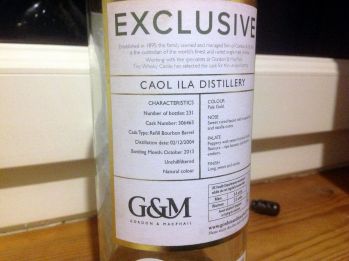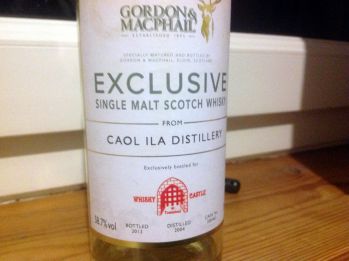“It’s all in the Wood” – or how to choose great malt whisky
Adventure Guide Andy Bateman of Scot Mountain Holidays guides you through the mist of romance and hype, and around the pitfalls in choosing a fine bottle of malt whisky.
Scottish Malt Whisky is simply not Scotch unless it’s been matured in an oak cask. Up until this point it is just spirit from the still. Essentially a mix of alcohol & water plus e.g. elements of smoke should the barley been dried over a peat fire.
A complex interaction between the oak and the spirit takes place during maturation with the alcohol drawing out many of the oils and other components of the wood. It’s the presence of these oils that gives the whisky’s depth of flavour and breadth of character. This is what Malt Whisky is so let’s look at ‘journey” these oils take during the whisky making process.
Quality of the Wood – are the oils still present?
Firstly, if there isn’t quality in the wood you won’t get the quality in the whisky. The oak casks are used a number of times and with each maturation, oils are removed from the wood. If you mature spirit in an exhausted cask, it doesn’t matter how long it slumbers, the whisky will lack quality. The two questions that need to be asked are:
How many times the cask has been used previously?
The majority of Scotch Malt Whisky is matured in ex-American Bourbon casks. This first maturation of Bourbon removes the harsher notes from the new oak. After the subsequent 1st and 2nd maturations of Scotch Malt whisky the wood starts to loose it’s quality. Up to 60% of the vital ingredients can be drawn out during the first maturation with the whisky produced from 3rd and subsequent maturations often being of a lower standard.
Malt whisky production is a batch process and each cask has its own individual characteristics depending on a range of factors. The world of single cask malt whisky is infinitely varied. For the malt marketeer this has traditionally presented a problem of consistency. Understandably when you find a whisky you like, you want to know that the next bottle will taste the same. This is where the Master Blender (aka “The Big Nose”) comes in. They will marry together up to 100 casks from the same distillery to produce a consistent single malt*. Some of these will be good 1st or 2nd refill casks, others will be the not-so-good 3rd or 4th generation.
* A blended whisky is a mixture of malt whiskies from different distilleries and grain whisky.
has the spirit had enough time to draw the oils out of the wood?
The traditional length of time that the spirit needs to mature is an issue for the industry. Due to demand there has been a recent tendency to downplay the importance of the age. Traditionally it was around 10 years or more. Some have partly got around it by decreasing the cask size to increase the wood to spirit ratio and hence shorten the maturation period. Laphroaig’s Quarter Cask expression being a prime example. There are some good young single malts but this is not to infer the maturation period is not a very important part of the process. It takes time for the oils to be drawn out of the wood. The harsher flavours are softened over time and so the age is an important factor in the quality of the final product.
Scotch Whisky is matured in the cask above 60% ABV i.e. “Cask strength”. The market for Cask Strength whisky is small and most people who enjoy a tipple find it too strong. Diluting cask strength whisky down to the industry agreed standard of around 40% abv greatly improves the marketability through reducing the price as well as improving the palate.
The problem now is the equilibrium that established itself in the cask is altered and there is now no longer a high enough concentration of alcohol to support the oils. There is a tendency to for the whisky to go hazy.
To overcome this problem the long chain oils in most commercial malt whisky are removed by chill filtering but it is these longer chain oils that give the whisky it’s depth of flavours and breadth of “character”. The chill filtering also removes some of the variability and makes the Master Blenders job a little easier in creating that brand flavour.
A large number of commercial malt whiskies are coloured with the addition of Caramel. This also affects the flavour of the whisky.
Distilleries are often produce casks which don’t fit in with the taste profiles they wish to create and are happy to sell these on to Independent Bottlers. It’s through these companies that you often get some of the best whisky at a good price.
Check out hiking holidays incorporating Whisky : Walking, Whisky & Wildlife or Mountains and Malts
Recommended distillery tours from Fraoch Lodge: Aberlour, Glenlivet, Glenfiddich. You could also try our self-guided whisky story tour, based from Fraoch Lodge
NB It’s rare to find a Scot who will talk about “Scotch whisky”. For Scots in Scotland, there is no such thing as Scotch whisky. We have whisky or malt whisky or single malt.
The Speyside Whisky Festival is just around the corner again. We thought we’d dust off this old blog of ours and give you some insider knowledge of what to look for if you’re coming up for if you want to take home a really special bottle of Malt whisky – a really special bottle of Scotch whisky.
We live on the edge of the whisky trail and can’t help but acquire pointers from the experts about how to choose a special Scotch whisky. Andy has paid close attention to Mike Drury of the Whisky Castle in Tomintoul who is a leading light in the whisky world. Mike retired from running the Whisky Castle a few years ago. He now enjoys a totally different relaxed lifestyle on the Isle of Mull. However, the new owners have been just as helpful to our guests (and Andy).
Here Andy shares the benefit of his many visits to whisky country so you too can go home with a unique bottle of whisky. There’s nothing like living in Scotland to develop your appreciation for “the water of life”, as whisky is known in Gallic.
When it comes to choosing fine malt whisky there are 4 things you need to know. In order of importance they are:
Too much emphasis is often placed on the age of the whisky and the distillery in it was produced. Every distillery has the potential to produce fine and not so fine malt whisky.

What to look for on a whisky label if you’re looking for a really special bottle – but don’t expect it to be “cheap”.
There are 2 aspects to this:
a) The number of times the cask has been used previously to mature Scotch Malt whisky
b) Whether the whisky is the product of single or multiple casks
To be classified as Scotch Malt Whisky it has to have been matured for a minimum of 3 years in the cask. Many distillers though will mature their whisky for a lot longer, usually around 10 years before they’re satisfied with the quality to release it for sale.
During the maturation period there is a complex interaction between the oak wood and the alcohol with the alcohol drawing out many of the oils and other components of the wood to create Scotch Malt Whisky. Up to 60% of theses vital ingredients can be drawn out after the first maturation of scotch malt whisky. During the life of a cask it’s easy to see that the wood can become quickly exhausted with the whisky produced from subsequent maturations being of a lower standard. If a tired cask is being used to mature whisky in it doesn’t matter how long the spirit is left in it to mature, the resultant whisky will lack quality/flavour. There are things that can be done to help rejuvenate the cask but the original qualities are never fully achieved.
The majority of malt whisky sold is the product of a number of casks ‘married’ together (up to 100), some good first refill/generation and some not so good 3rd or 4th refill/generation.
On the bottle label you should be looking for the whisky being single cask and 1st or 2nd refill/generation.
The spirit is matured in the cask at around 60%ABV. This results in an equilibrium being established between the strength of the spirit and it’s ability to draw out and “carry” the various oils, etc of the wood. Most scotch malt whisky is diluted with water and sold at around 40%ABV.
This dilution in itself results in the whisky becoming cloudy as there is no longer the concentration of alcohol to support the oils i.e. an emulsion is starting to form. There is nothing wrong with the whisky at this point other than it maybe appearing less appealing. To get around this problem much of the malt whisky sold is chill-filtered. Cooling the whisky makes the heavier oils more viscous allowing them to be removed by a5 to 3micro filter. The issue is that these heavier oils, etc are what give a good malt whisky it’s depth of character and flavour
You should be looking on the label for the words “unchillfiltered” or “non chill filtered” and the ABV should be 46% or more. If the whisky is below 46%ABV it’s a sure sign it has been chill filtered.
(One issue here is that some countries do not allow the importation of alcohol for re-sale with an ABV above 40%.)

Whisky tasting under the expert guidance of Mike Drury when he was in control at the Whisky Castle
Whisky is stored in wooden casks, usually made of white oak. Presuming the spirit is being matured in a quality cask, there is complex interaction between the wood and the spirit. This interaction is a slow. The harsher flavours of the whisky are softened over time. The age of the malt whisky is an important factor in the quality of the final product though whisky doesn’t necessarily always continue to improve with age.
Generally you will be looking for a minimum of 10 year old whisky.
It’s tempting but don’t ever judge a malt whisky by its colour. A lot of malt whisky has caramel added to make it darker. It also of course alters the flavour. This is the only additive that is allowed to be added to Scotch Malt Whisky
You should also be looking for words like “natural colour” on the bottle

Exclusive whisky from Gordon & Macphail
Generally its independent bottlers who deal in high end malt whisky and available through specialist whisky shops.
Independent Bottlers:
……. to name a few.
Specialist Whisky Shops:
The Whisky Castle, Tomintoul is an independent whisky store with 500 malt whiskies listed online. They specialise in independently bottled, non-chillfiltered, non-caramalised, single cask, single malt whiskies.
Whisky month – join Scotland in a month-long celebration of our national drink. Whether you’re a whisky novice or a whisky connoisseur, there’s something for everyone to do, including our Mountains and Malts trip.
The Speyside Whisky Festival – discover the passion behind the world’s finest whiskies
Whisky trail – Follow the world-famous Malt Whisky Trail through Speyside to seven working distilleries, including a fascinating cooperage and a historic distillery.
Looking for something to do while your partner explores a distillery and whisky related stuff – try Three Bags Wool in Aberlour
All content © Copyright Scot Mountain Holidays 2025
Responsive web design by Summit Web Solutions